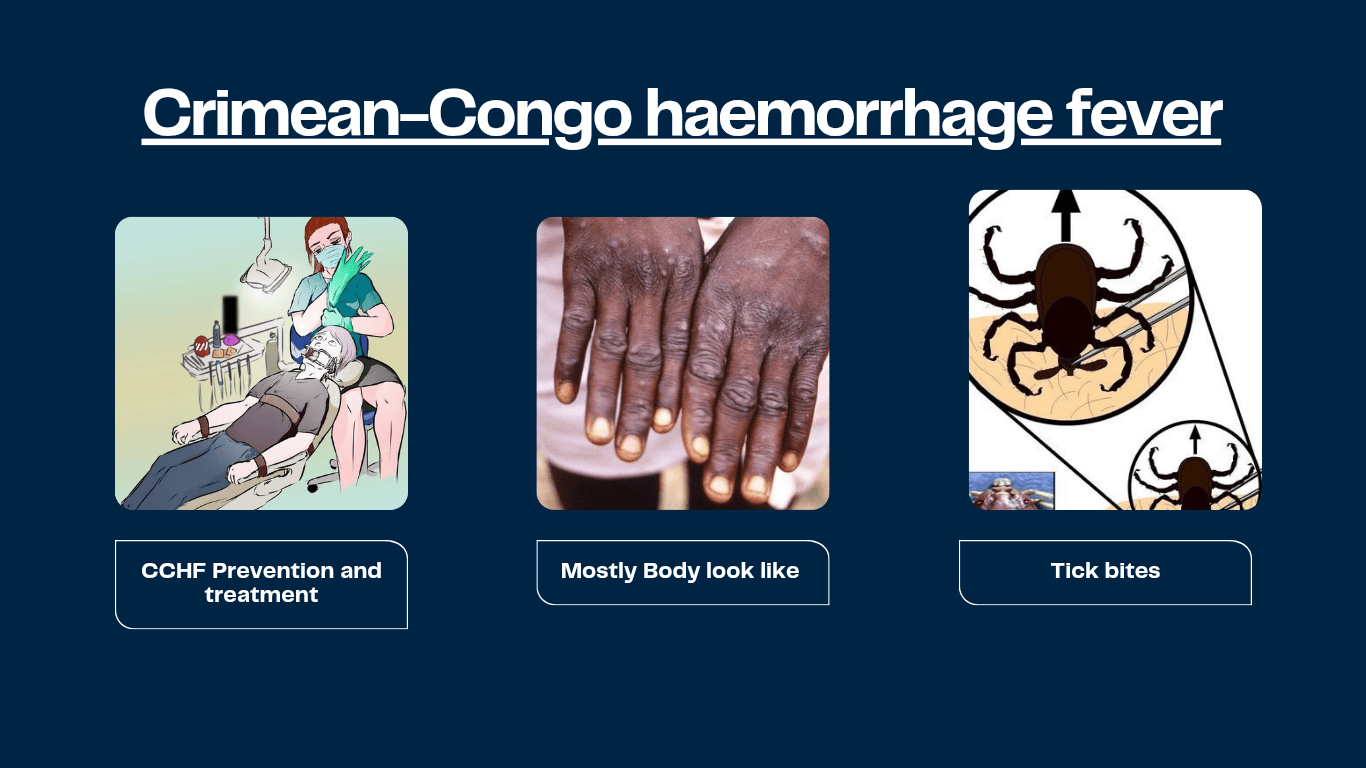Congo Virus
Q1: What is Crimean-Co[ngo Hemorrhagic Fever (CCHF) virus?
Crimean-Congo haemorrhagic fever: This virus has become much more common today. The Congo virus is a very severe viral hemorrhagic fever. Which belongs to the family Nairoviridae and the order Bunyavirales12.
Q2: First reported case of Congo virus in which city?
The first reported case of Congo virus is called the “Crimean-Congo Hemorrhagic Fever (CHF).” This case was identified in Stanleyville (now Kisangani). The first case in Pakistan was reported in Rawalpindi in 1976.
Q3: Origin and cause of Crimean-Congo Hemorrhagic Fever (CCHF)?
- Origin: CCHF was first identified in Crimea in 1944. However it was identified in Congo in 1956.
- Cause: It was first transmitted by tick bites. And it is mostly spread through contact with infected animals. However, this virus is transmitted from person to person. And From human to humans through bodily fluids.
Q4: Symptoms and diagnosis of Crimean-Congo haemorrhagic fever?
Initial symptoms of this Congo virus
- Fever
- Severe headache
- Diarrhea
- Vomiting
- Nausea
- Photophobia
- Sore eye
- neck pain
- abdominal pain
- dizziness
Gradually increase in symptoms
- Mood swings
- Enlarged liver
- Large bruises
- Small skin hemorrhages
- Excessive bleeding
Last stage
- Excessive nosebleeds
- Excessive bleeding at the injection site
- Jaundice
- Excessive organ failure
Diagnosis:
- Methods: They generally include antibody, and viral RNA or antigen detection in blood samples.
- Timing: Symptoms appeared 1 to 13 days after active contact. However, at acute stage diagnosis was often recorded.
Q5: Is there a vaccine for Congo virus? Treatment and prevention of Crimean-Congo Hemorrhagic Fever?
There is not currently available any vaccine for CCHF (Crimean-Congo haemorrhagic fever). But one an inactivated vaccine used for highly risk groups.
CCHF Management:
- Basic Management: it includes general supportive measures that include fluid management, component replacement, and hemodynamic support.
- Antiviral Use: Ribavirin is used off-label sometimes though its efficacy has not been proven or supported by strong clinical evidence.
CCHF Prevention:
- Tick control: make sure to wear protective clothes to avoid tick bites.
- Handling of animals: be cautious when handling animals in endemic regions.
- Health Care Precautions: Maintain strict barrier nursing practices to prevent nosocomial transmission.
Q6: Reported cases of Crimean-Congo haemorrhagic fever worldwide (CCHF global statistics)?
The disease is now endemic in Africa, the Balkans, the Middle East, and some part of Asia, with a high case fatality rate of between 10% and 40% rates.
Q7: Countries affected by Congo virus outbreaks (CCHF affected regions)?
- Afghanistan: The rate of fatality is not specified but outbreaks of the disease have been reported.
- Albania: Endemic per se, the cause does not present case fatality rate.
- Bulgaria: Endemic per se, the cause does not present case fatality rate.
- China: Reported cases; specific mention of any fatality rate lacking.
- Democratic Republic of Congo: Part of the endemic region; no specific case fatality rate reported.
- Greece: Endemic; no specific case fatality rate reported.
- India: Outbreaks reported even though case fatality rate was not specified.
- Iran: Fatality rate reported with significant outbreaks, but exact rate is not specified in recent updates.
- Iraq: Sporadic cases; fatality rate not specified.
- Kazakhstan: Case reports; fatality rate is not specified.
- Kosovo: The case fatality rate was reported to be 25.5% between 1995 and 2013[1].
- Kuwait: Some sporadic cases with an unspecified case fatality rate.
- Madagascar: Endemic; fatality rate not specified.
- Mauritania: Outbreaks reported; fatality rate not specified.
- Montenegro: Endemic; fatality rate is not specifically stated.
Other countries are
- Oman: Sporadic cases; fatality rate not specified.
- Pakistan: Outbreaks reported with a case fatality rate above 10% in some instances.
- Russia: Outbreaks reported but without a specification of the case fatality rate.
- Saudi Arabia: Sporadic cases; case fatality rate is not specified.
- Senegal: Part of the endemic region; case fatality rate is not specified.
- Serbia: Endemic; case fatality rate is not specified.
- South Africa: Significant outbreaks, but case fatality percentage is unspecified.
- Sudan: Part of the endemic region, with no reported case fatality rates.
- Tajikistan: Some case reports known; fatality rate remains unspecified.
- Turkey: Significant outbreaks with reported deaths, although recent updates are silent about exact fatality rates.
- Uganda: Outbreaks have been reported, and the degree of fatality is yet to be determined.
- Uzbekistan: Outbreaks reported, but the case fatality rate has not been specified.
- United Arab Emirates: In actual some sporadic cases have occurred. But there is no specification has been made about the fatality rate.
General Case Fatality Rate: 10%40% across the zones affected by the disease
Research in 2024 shows that North Macedonia registered two cases of CCHF in the year after 50 years- an indication of high clinical vigilance and viral reassortment. In a man with tick exposure, RT-PCR confirmed the presence of CCHFV. Genetic analysis indicates this region as a convergence point for strains coming from Turkey and Kosovo, warranting a greater need for surveillance.
Other virus The NIH confirms that HMPV, now spreading in China, has existed in Pakistan since 2001

